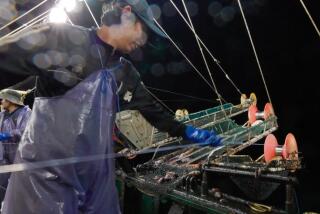Is Carp in a Can a Potential Cash Crop?
- Share via
WASHINGTON — Don Freeman doesn’t want to hear any carping about his pet project. He thinks it could provide American agriculture with another cash crop.
Freeman, an Agriculture Department food scientist in Pine Bluff, Ark., is testing the water for possibly marketing canned carp--like canned salmon or tuna. Only he thinks it tastes better--and without sharp bones.
Freeman acknowledges a canned carp industry would be hard-pressed to erase the perception of a “trash fish” that eats off the bottom of ponds and sluggish rivers, and whose flesh is filled with tiny bones.
“Those who tasted it [during market testing] but didn’t know what it was, liked it,” he said. “Eighty percent wanted to know what it was and where they could get it.”
In fact, more than 60% said that it tasted better than tuna and that they would be willing to pay as much for carp as they do for tuna.
“Some of the tasters thought we were feeding them chicken,” Freeman said. “But when told the fish was carp and asked if they would buy it off the shelf, most said no.”
Still, Freeman noted that rural Americans have been canning river carp native to the United States for years, a process that softens the bones the same way it does salmon.
And he believes that there could be an immediate market among the growing Asian population in the United States. Noting the export potential, he also said the University of Arkansas at Pine Bluff is studying the possibility of European marketing.
The bighead carp is a silvery fish with firm flesh that comes out of a can “as white as a piece of paper,” he said. It also has a growth rate four times that of catfish and can weigh up to six pounds after just a year.
The Agriculture Research Service says canned carp is healthy, with less than 2% fat, but loaded with calcium and protein. It also contains fatty acids linked in some studies to reduced heart disease and other benefits.
The fish was brought to the United States during the 1970s from Asia to help maintain water quality in farm ponds used to grow catfish for supermarkets. They eat plankton, the minuscule animal life that is naturally available, unlike a cousin, the grass carp, that was imported to keep ponds unclogged by aquatic weeds.
“That’s the beauty of it--you don’t have to feed it. The pond feeds it,” Freeman said. And since catfish farmers already are growing bighead carp, production won’t be a big learning experience for them.
The university did a limited market survey in the early 1990s and found the product promising enough to warrant further study. Freeman said the Agricultural Research Service got involved in 1994 because the university did not have the expertise for the additional survey.
The canned carp project operates on “a shoestring budget,” Freeman said, explaining that it’s part of the ARS Aquaculture Systems Research Unit’s study of catfish production. He estimates the carp study itself has cost taxpayers about $15,000 stretched over three years.
“It’s a potential new freshwater fish product,” he said. “It may provide additional income to fish farmers and expand the aquaculture industry.”
But although there has been “quite a bit of industrial interest” in canned carp, he’s not ready to recommend it yet.
“It’s a work in progress,” he said. “I don’t know yet if it will go.”
More to Read
Eat your way across L.A.
Get our weekly Tasting Notes newsletter for reviews, news and more.
You may occasionally receive promotional content from the Los Angeles Times.










